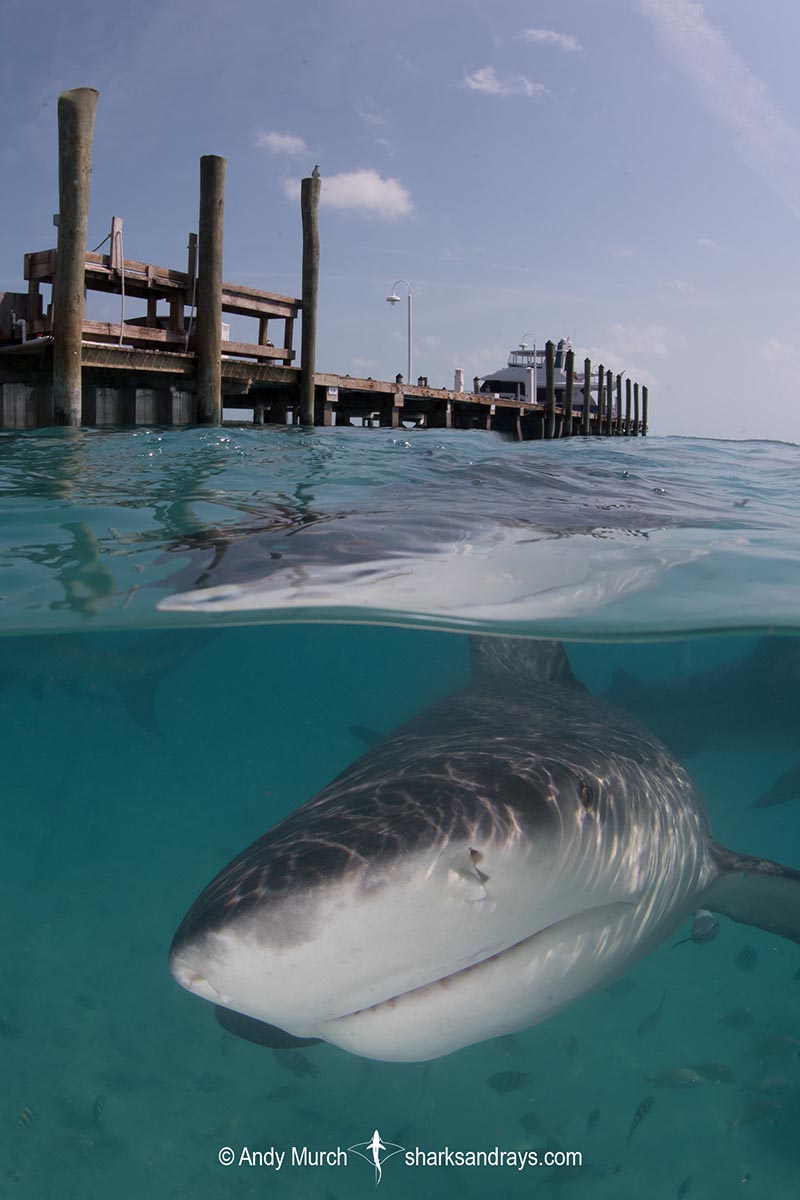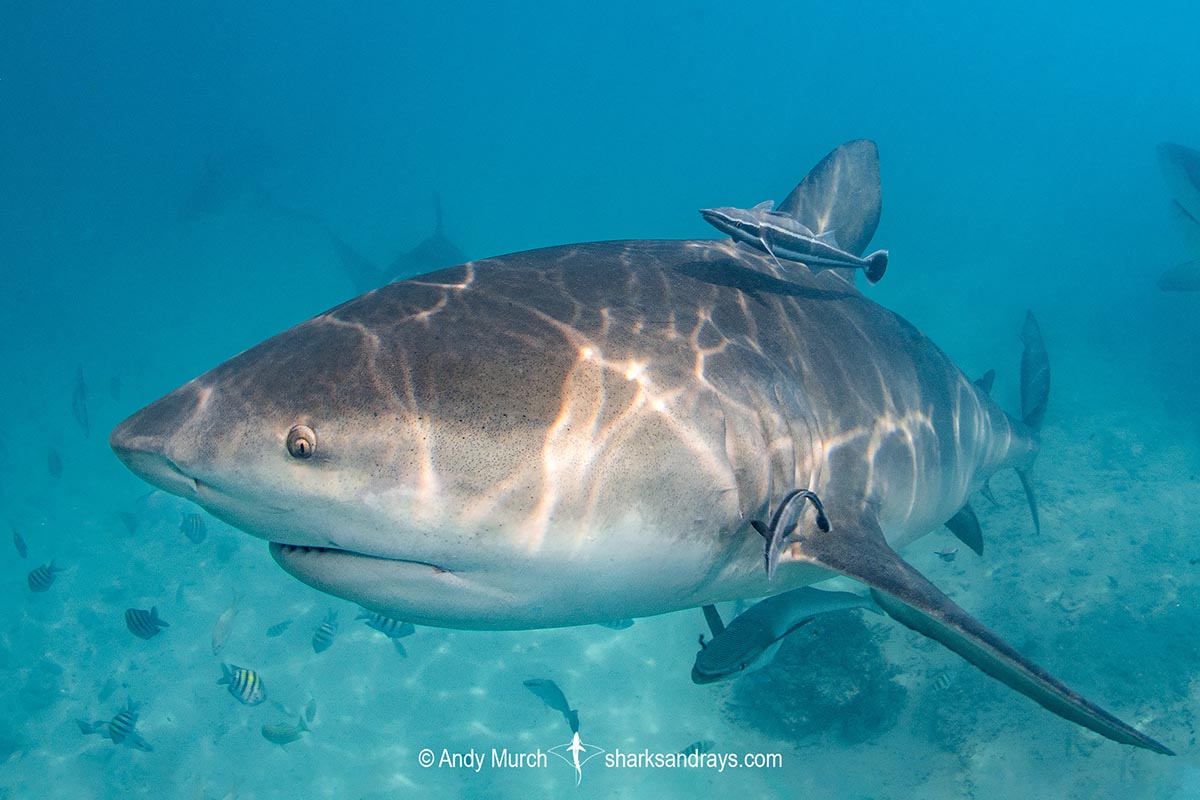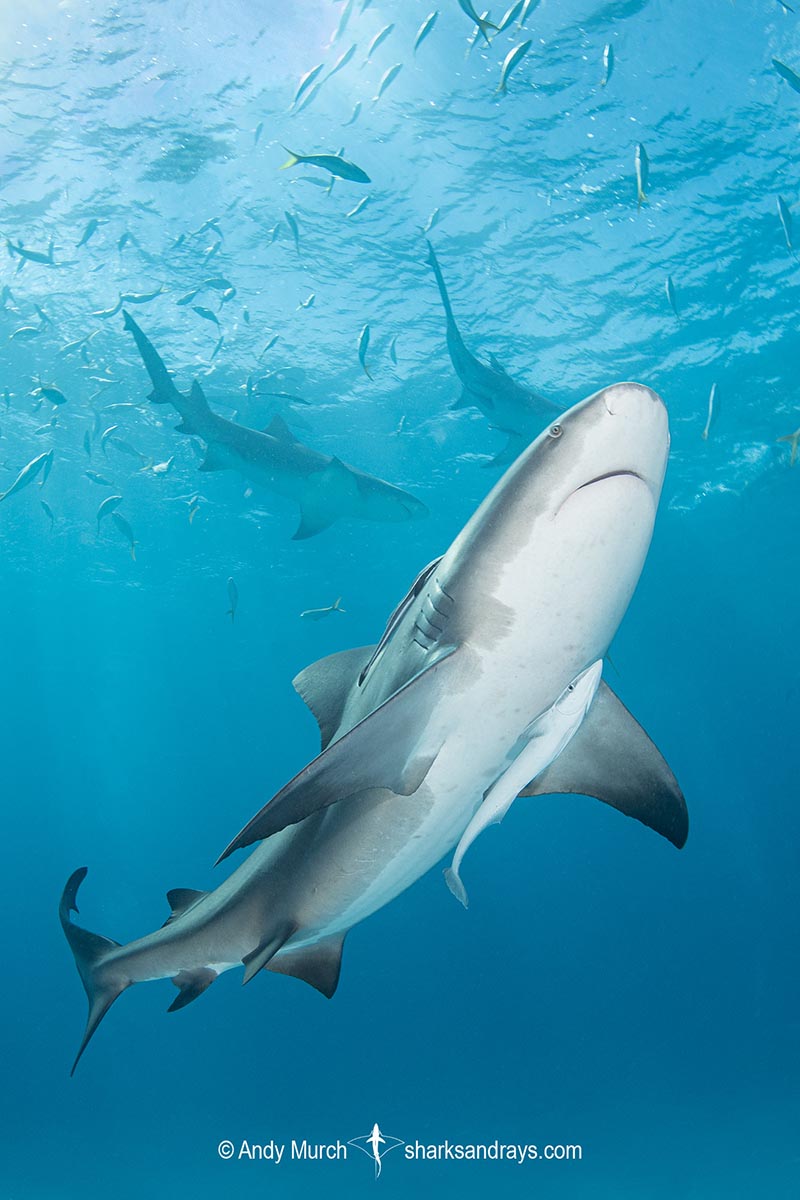Common names
Bull Shark, Lake Nicaragua Shark, Zambezi Shark.
Binomial
Carcharhinus leucas.
Synonyms
Carcharhinus azureus, Carcharhinus nicaraguensis, Carcharhinus vanrooyeni, Carcharhinus zambezensis, Carcharias azureus, Carcharias leucas, Carcharias spenceri, Carcharias zambesensis, Carcharias zambezensis, Carcharicus leucas, Carcharinus leucas, Carcharinus zambesensis, Carcharinus zambezensis, Eulamia nicaraguensis, Galeolamna bogimba, Galeolamna greyi mckaili, Galeolamna leucas, Galeolamna mckaili, Prionodon platyodon, Squalus obtusus, Squalus platyodon.
Identification
Stout body. Head wide and bluntly rounded with a very short snout and small eyes. Broad triangular first dorsal fin; origin level with pectoral fin axil. First and second dorsal fins have short free rear tips. No interdorsal ridge. Subtle caudal keel. Dorsal colouration grey or grey/brown, occasionally with irregular darker blotches. Fins unmarked or slightly dusky towards tips/posterior margins; more noticeable in juveniles.
Size
Maximum length at least 324cm. Size at birth 56-81cm.
It is estimated that bull sharks may live for more than 50 years.

Conservation Status
VULNERABLE
The bull shark is a common bycatch component in many fisheries including gillnet and longline. It is also a targeted species in some areas.
Due to strict regulation, the population is increasing in the northwest Atlantic, but declines have been reported across most other regions. In South Africa, bull shark population declines appear to be linked to habitat degradation.
Based on data of declines in overall whaler shark populations, it is estimated that worldwide, bull sharks have declined by 78% during the last three generation lengths (68yrs).

Habitat
A warm water species preferring temperatures of 26ºC or warmer. Found on inshore reefs and bays. It is a euryhaline species that travels thousands of kilometres up large rivers and into lakes that access the ocean. Surface to at least 152m.
Distribution
The bull shark has a cosmopolitan distribution in tropical and sub-tropical nearshore environments. It has been recorded hundreds or thousands of kms in the Amazon, Mississippi, and other large rivers of the tropics.
Reproduction
A viviparous species with yolk-sac placenta. 1-13 pups per litter, around 10 on average. Gestation is approximately 12 months. Mating occurs biannually.
Diet
Diet consists of a wide range of bony and cartilaginous fishes, and molluscs. Juveniles in Florida feed heavily on catfishes and stingrays. Larger animals are known to eat jacks, tarpon, mullet, and smaller sharks. Bull sharks are cannibalistic; the stomach of a 162cm specimen contained the head of an estimated 80-90cm bull shark.
Behavior
Bull sharks mostly cruise close to substrate. They are known to travel over long distances, migrating into warmer water over the winter months. Bull sharks are well known for ability to tolerate fresh water. They have been found thousands of miles upriver but it is unclear if they are residents or nomadic in the world’s great tropical rivers.
Reaction to divers
Bull sharks seem to have quite sensitive hearing, making them difficult to approach in un-baited situations. CAUTION: In baited situations bull sharks quickly become very aggressive and potentially dangerous. They are responsible for numerous attacks on humans, some of which were fatal.
Diving logistics
Bull sharks are seem by divers in numerous locations, both with and without the use of bait.
In southern Africa, there is a long-standing bull shark feed in the summer months at Protea Bank, south of Durban. Further north at Ponta Do Ouro, Mozambique, divers often encounter bull sharks during reef dives.
In Fiji’s Beqa Lagoon, there is a daily shark feed that attracts scores of large, aggressive bull sharks as well a s a few smaller species and the occasional big tiger shark.
On the Atlantic coast of Mexico, there is a well established bull shark feed at Playa del Carmen. The dive usually attracts around 2-12 sharks. The season runs from November until March at which point the sharks (most of which are gravid females) leave to deliver their young.
At Cabo Pulmo on the west side of the Sea of Cortez, Bull sharks are becoming increasingly more abundant. It is not uncommon to see five or six on a single dive.
In the Bahamas, bull sharks regularly show up at the great hammerhead feeds in Bimini from November until around April when the hammerheads begin their migration and the feeds slow down. Likely the bull sharks remain for much of the year. The operators make a point of not feeding any of the bull sharks during the hammerhead dive because they quickly become too aggressive. In fact, if the bulls start to show too much interest or approach too closely, the feeder will tap the metal bait crate with his feeding pole; an action that immediately scatters the bull sharks but has virtually no effect on the hammerheads.
At Big Game Club Marina on North Bimini Island, it is possible to enter a small shark cage that is tied to the dock. A feeder will then entice some of the resident bulls up to the bars. Although the cage itself is mostly for non-diving tourists, this is an excellent location to capture over/unders of bull sharks (see image gallery).
Bull sharks also show up at Tiger Beach; the name given to a group of dive sites on Little Bahama Bank north of Grand Bahama. The bulls do not remain there year round but we usually see a handful swimming around when we go each April: Tiger Beach Trip
Similar species
Caribbean Reef Shark Although this species is more slender, divers consistently mistake large CRSs for bull sharks. It is distinguished by its longer snout and noticeably higher, shorter first dorsal fin.
Pigeye Shark Very similar looking species i.e. thick-bodied, with a short snout, small eyes, and a triangular first dorsal. Distinguished by the relative size of the dorsal fins. Pigeye first dorsal is greater than 3.5 x height of second dorsal. Bull first dorsal is less than 3.5 x height of second dorsal.























